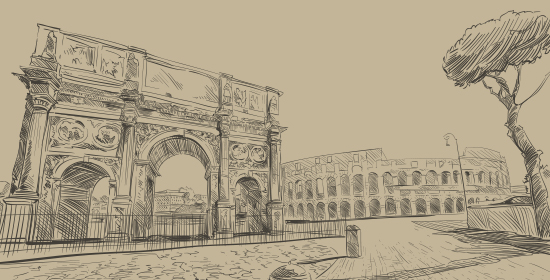7 Top Ancient Roman, Etruscan Sites to Visit from Rome

Buon giorno and welcome to Stefano’s RomeCabs, Rome’s leading company for Day Tours from Rome, and Shore Excursions from Civitavecchia and Italy’s top cruise ports.
Some of the many interesting things in Italy that draws millions of visitors each year are the fascinating ancient sites that date back to Etruscan and Ancient Roman times. Both ancient civilizations have left their marks throughout Italy, but not nearly as much as in Central Italy where the Etruscans settled and Rome was “caput mundi” – “capital of the [ancient] world”.
In this region of Italy, you have the unique opportunity to visit ancient sites and locations that don’t exist anywhere else in the world! So on your next trip to Italy, try to visit at least some of the 7 Top Ancient Roman, and Etruscan Sites to Visit from Rome and you will not be disappointed!
- Banditaccia Etruscan Necropolis in Cervereri
- Monterozzi Etruscan Necropolis in Tarquinia
- Ancient Roman Amphitheater in Sutri
- Ostia Antica
- Hadrian’s Villa / Villa Adriana
- Via Appia Antica / Ancient Appian Way
- Park of the Aqueducts
Because these amazing locations are so historically and architecturally significant and frequently requested, they are included in many tours offered by our company, as well as our sister company Stefano Rome Tours.
You may simply visit these incredible places on your own, or you may book any of our tours that include these locations, or request a customized tour to include as many of these ancient Roman, Etruscan sites to visit from Rome.
We also included Photos and Videos so readers can have a visual understanding of these amazing ancient places as well.
7 Top Ancient Roman, Etruscan Sites to Visit from Rome
WHO WERE THE ETRUSCANS?
When travelers think of Italy’s ancient past, the first thing that comes to mind is ancient Rome!
Most do not know that before there were Romans living on the Italian peninsula, there were the Etruscans, and the area they settled in central Italy was known as Etruria.
The Etruscan civilization is draped in mystery in terms of where these people originated from and their language and alphabet – most of which are not yet understood because they did not leave behind books or literature. As they built mostly using wood and terracotta, their structures did not survive the millennia like the ancient Roman buildings of stone and marble have. Most of all the knowledge we have about the Etruscans comes from grave goods found inside their tombs, and many preserved in museums.

However, we do know that the once primitive small city-state of Rome had 7 Etruscan Kings before the Romans revolted, dethroned the last Etruscan King, and became a Republic. As Rome grew bigger and stronger, it sought to expand its power and territory, and over the course of a few hundred years, Rome conquered all the Etruscan city-states and absorbed them into the ever-growing Roman Empire – marking the end of the Etruscan civilization.
The Etruscans were one of the most advanced civilizations of ancient times, on par with Ancient Greece. In fact, many of the things that we attribute to the Romans were Etruscan inventions (sewer systems, arches, togas, gladiator sports, and more!)
Most of the knowledge we have about the Etruscans came from what was discovered inside their tombs in their vast necropoli such as in Cerveteri and also in Tarquinia (see below the Etruscan Necropolis of Tarquinia).
Banditaccia Etruscan Necropolis in Cerveteri
Cerveteri was once a prominent Etruscan city-state in the Etruscan League known as Cisra. Later it became known as Cerveteri.
The Banditaccia Necropolis in Cerveteri covers about 1,000 acres with thousands of burial sites. The area open to visitors is only about 25 acres with about 400 tombs in the shapes of domes and dice – many of which you can enter and explore.
As the Etruscan civilization advanced from its beginnings in the Villanovan period of the 9th century BC to around the 4th-5th centuries BC so did the complexity of their burial sites. In the early period of the Etruscan era, you can see throughout the necropolis stone urns that contained the ashes of the deceased, and shallow graves. Over time, burial sites grew in size and complexity as “huts” and square dice-shaped buildings were carved right out of the tuffa rock to represent the actual homes of the deceased.

When they ran out of surface space, they began to dig their tombs underground as you will see in the more “modern” Tomb of the Reliefs.
10 Most Amazing Etruscan Tombs at Banditaccia Necropolis in Cerveteri
By the 3rd century BC which marked the end of the Etruscan civilization, their tombs were built in structured city-like blocks with roads for processions and squares for gatherings. Inside the tombs, you can see multiple rooms like in a home, with stone carved beds as in a bedroom where the deceased was laid to rest, as well as stoned cut furniture such as chairs, and ornaments such as awnings, columns, and cornices.

While we may not know what the actual homes of the Etruscans looked like as we know of the ancient Romans from the ruins in Pompeii and Ostia Antica, by exploring the tombs in Cerverteri we have an idea just be exploring the tombs of this ancient yet advanced civilization.
TOURS THAT INCLUDE BANDITACCIA ETRUSCAN NECROPOLIS
COUNTRYSIDE SPLENDOR
OSTIA ANTICA AND CERVETERI
Monterozzi Etruscan Necropolis in Tarqinia
A former prominent ancient Etruscan city-state known in ancient times as Tarchuna by the Etruscans and Tarquinii by the Romans. Roman also had 2 Etruscan kings by the name of Lucius Tarquinius Priscus, and Lucius Tarquinius Superbus (the last of the 7 Kings of Rome).
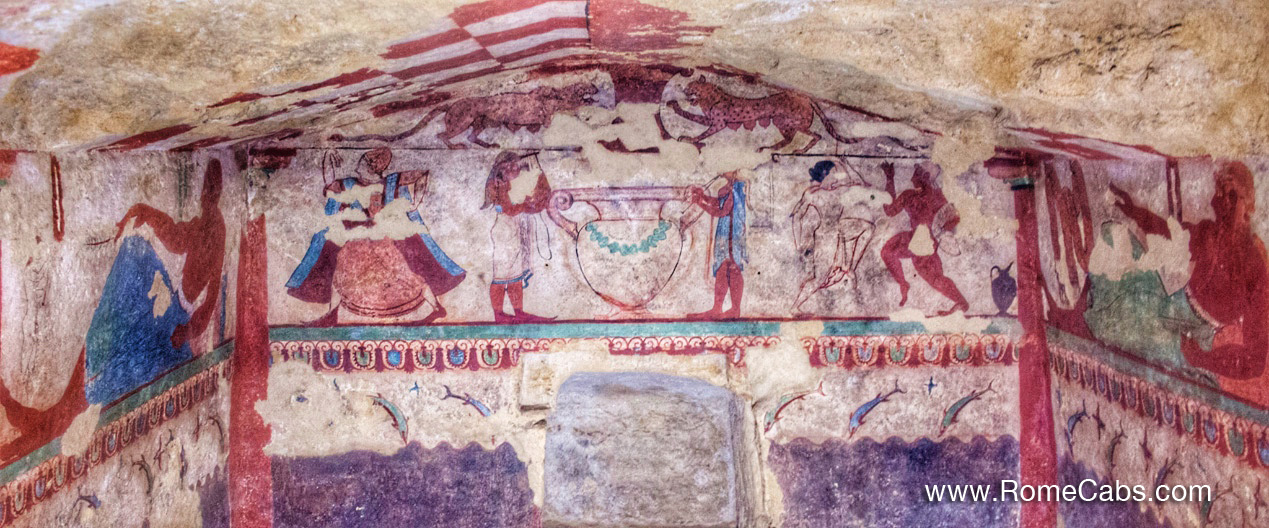
On a hill east of Tarquinia is the Monterozzi Etruscan Necropolis which dates as far back as 7th century BC. Of the estimated 6,000 tombs known to exist in this necropolis, about 200 of them were decorated with frescoes.
Unlike the Banditaccia Necropolis in Cerveteri with above-ground tombs that you can enter and explore, the tombs in Monterozzi Necropolis in Tarquinia are underground and accessible by descending a flight of stairs below ground.
Open to the public are about a dozen painted tombs at a time, and they are sealed off with temperature and humidity controls for the preservation of these ancient fragile frescoes. The tombs can be viewed from the window of the metal door, with a light timer that you can turn on by pressing a button to view the interior of the tombs.
What makes these painted Etruscan tombs so incredibly special?
Many of the scenes depicted on the walls of the tomb interiors are of Etruscans (usually among them the deceased who once occupied the tomb), giving us a rare glimpse into the life of this ancient mysterious civilization.

Through their paintings, we see how they looked, how they dressed, how they did their hair, how they accessorized, what they ate, how they celebrated, the instruments they played music on, how they danced, the games they performed, how they hunted and fished, and more!
Through the representation of ancient artists who painted these frescoes in great detail and using vibrant colors, we come face to face with these amazing people and the kind of lives they lived.
TOURS THAT INCLUDE VISIT TO TARQUINIA ETRUSCAN NECROPOLIS
ETRUSCAN MYSTERY TOUR
The ancient Amphitheater and Etruscan Tombs of Sutri
Modern-day Sutri is a medieval town with ancient roots about 30 miles from Rome. In ancient times, Sutri was known as Sutrium and considered the “Gateway to Etruria” by Livy as it occupied a strategic road to ancient Etruria (and later in Roman times, the Via Cassia).
After Rome conquered the city-state of Veii, Stutri continued to retain its strategic significance through the Roman era, into the Middle Ages and onward. Located outside of the current medieval town of Sutri literally on the side of the main road, is the ancient 2nd-1st century BC elliptical amphitheater approximately 49 by 40 meters with three rows of bleachers.

Unlike the famous Roman amphitheater known as the Colosseum that was built of stone, this ancient amphitheater was entirely carved right into the local tuffa rock, much like how the Etruscans created many of their tombs by carving them entirely from the living rock.
It is estimated to have been able to accommodate up to 9,000 spectators at a time, and the structure retained many of its features such as corridors, internal passages, and staircases.
Buried and forgotten over time, it was rediscovered by mid 19th century, and unearthed completely by the 1930s.
Right next to the amphitheater carved into the vertical cliffs at various heights are more Etruscan tombs. The Etruscans adapted to their environments and built their burial tombs by either cutting them from the living rock such as in Cerveteri, building them underground like in Tarquinia, or carving them right into the rocky cliff sides at various heights and elevations.
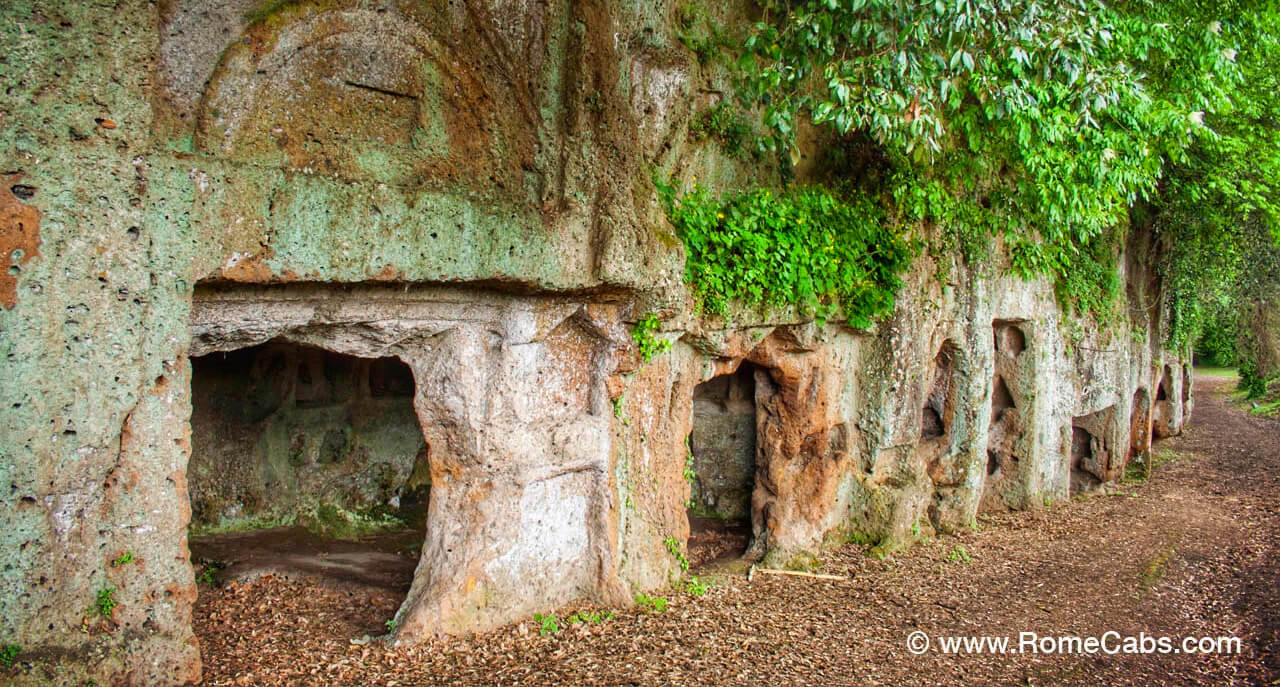
Also nearby at the foot of Savorelli hill, carved right into the vertical rocky cliff is a small church dedicated to Madonna del Parto. However, in ancient times it was a Mithraeum - an ancient Roman pagan temple dedicated to the pagan god Mithras.

Many ancient Roman pagan temples (such as also the Pantheon), were converted into Christian churches – thus aiding in preserving these ancient sites from perishing from abandonment or human destruction. Not frequently open to the public, it is very much worth visiting if you find it open when you are in the area.
TOUR THAT INCLUDES VISIT TO SUTRI
VITERBO, CALCATA AND SUTRI TOUR
OSTIA ANTICA
Currently, Ostia Antica is a large archaeological park similar to Pompeii, with an incredibly preserved ancient Roman city that you can walk through, and explore, and gives you a rare glimpse into ancient Roman city life.
But unlike Pompeii, Osita Antica is smaller, less crowded, and more tranquil in a park-like setting with shady sea pine trees.
About 15 miles southwest of Rome, Ostia used to be a 1st century BC harbor city of ancient Rome (and an outpost), then located at the mouth of the Tiber River. Due to silting, Ostia is now about 2 miles more inland than during ancient Roman times.
Beautifully preserved, you have the opportunity to see and visit ancient Roman apartment buildings, temples, villas with vibrant frescoes still visible, a theater, thermal spas with gorgeous mosaics, eateries, public baths and latrines, shops, and more.
Among the must-sees things in Ostia Antica are:
Baths of Neptune – public baths with intricate black and white floor mosaics
Piazzale delle Corporazione - a sharp U-shaped piazza lined with cubicle-size shops with floor mosaics in front of each one depicting the wares sold or the type of business conducted there.
Theater - just vis a vis Piazzale delle Corporazione (square of the commercial businesses) is a perfectly preserved semi-circular theater, large enough to seat up to 2,700 spectators. This theater is still in use today for special plays featured inside Ostia Antica in the summer.

Capitolium and Forum - the elevated brick-based structure was the religious center of Ostia, and across the way southward from the Capitolium was the Forum with ruins of the 1st century AD Temple of Roman and Augustus.
Via della Casa dei Diana - located in a residential part of the ancient city, this street is lined with insulae – large blocks of multi-level apartment buildings that housed commercial businesses on the ground floor, and living quarters above.
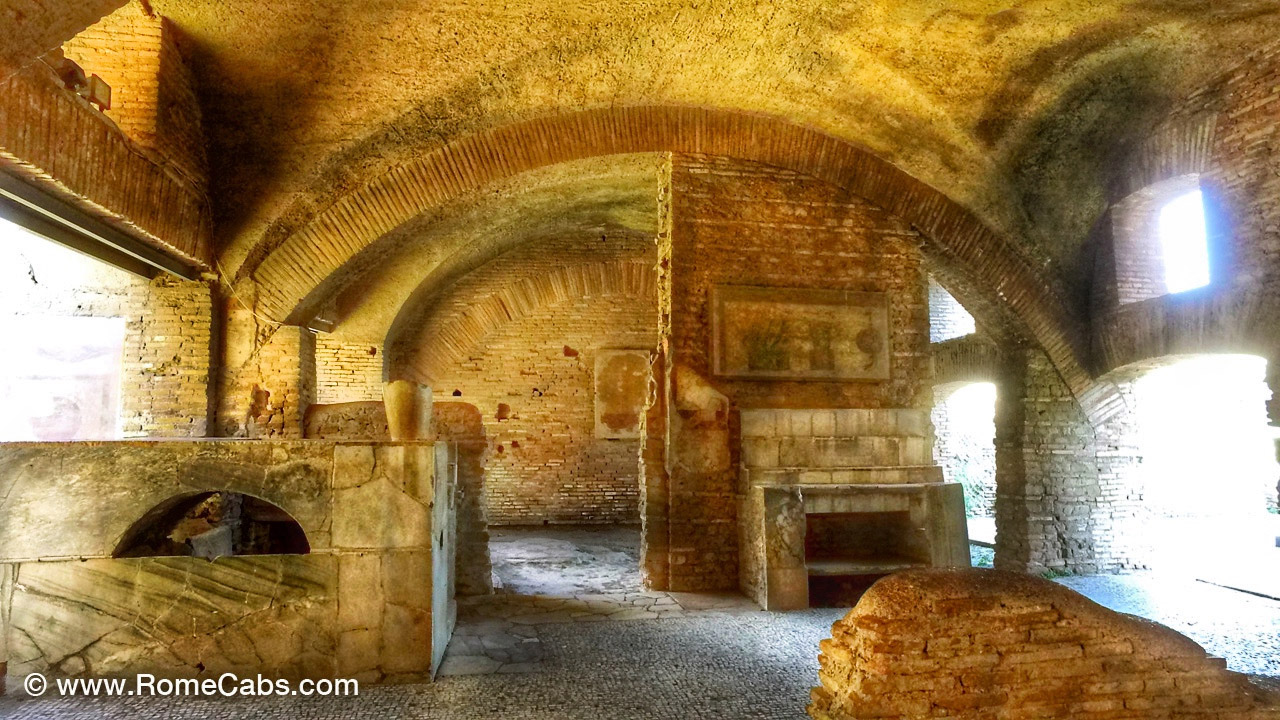
Thermopolium - on Via della Casa dei Diana is also the Thermopolium, a 4th century AD ancient Roman tavern frequented by folks of lower social status such as urban dwellers, merchants, sailors and port workers, and slaves.
Frescoes on the walls depicted images of what food this diner served. A marble counter at the entrance may have been where food and drinks were sold. This could well have been the “fast food joint” of Ancient Rome!
TOURS THAT INCLUDES a VISIT TO OSTIA ANTICA:
HADRIAN’S VILLA – TIVOLI
Hadrian’s Villa (Villa Adriana in Italian) is a large imperial complex built by Roman Emperor Hadrian in the 2nd century AD in the area of the current city of Tivoli.
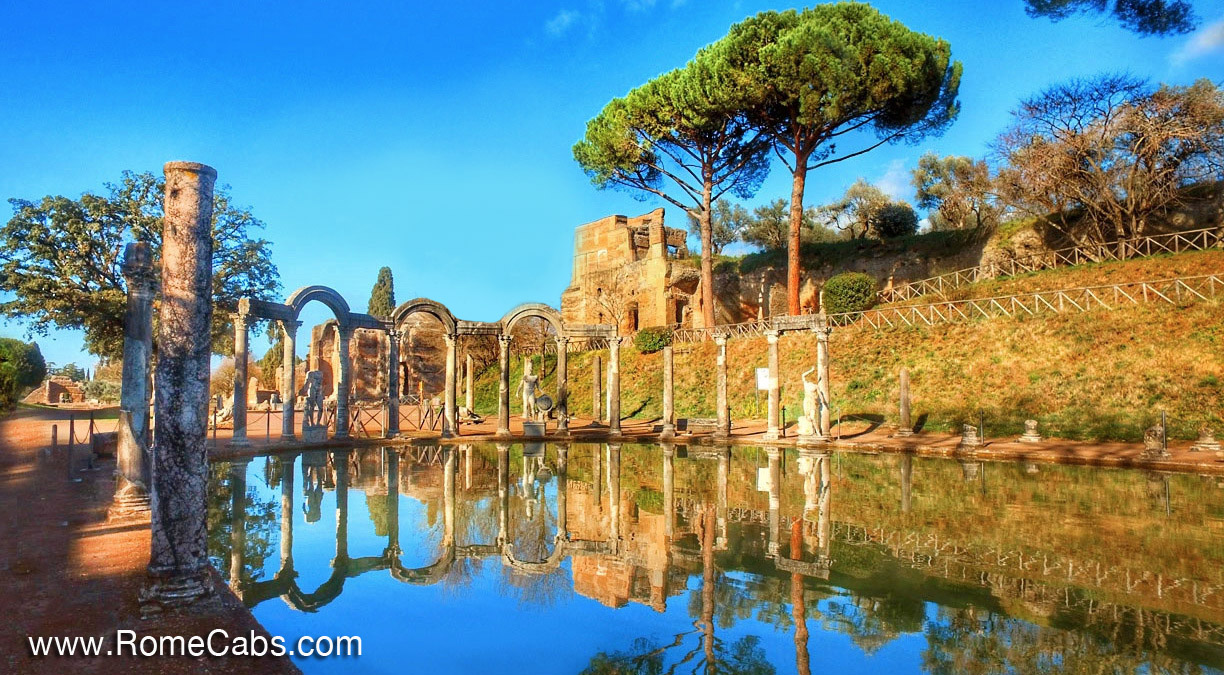
This vast complex from here the Emperor also ruled the Roman Empire spread over an area of around 200 acres, of which about 100 acres can be currently visited.
Hadrian’s Villa includes many buildings such as the imperial villa, residential buildings, libraries, theaters, temples, spas, nymphaeum, pavilions, pools of water, and gardens adorned with sculptures. It is an amazing ancient site to enjoy on your summer visits to Rome.

Emperor Hadrian loved architecture and is known to have dedicated himself to the characteristics of this vast complex (as well as other architectural masterpieces such as the Pantheon and Castle Sant’Angelo which was originally his mausoleum).
Currently, also a UNESCO World Heritage Site, Hadrian’s Villa makes for a splendid visit exploring the many massive and magnificent structures fit for an emperor.
TOUR THAT INCLUDES a VISIT TO HADRIAN’S VILLA:
TIVOLI VILLAS AND GARDENS and POST CRUISE TIVOLI TOUR
VIA APPIA ANTIA / ANCIENT APPIAN WAY
When they say “All Roads lead to Rome” what comes to mind is Via Appia Antica (the Ancient Appian Way) which was regarded in ancient Rome as the Queen of the Long Roads (Appia longarum… regina viarum) connecting Rome (beginning near Circus Maximus) to Brindisi (in the heel of the Italian peninsula in the Apulia region) making it a strategic road for troops and military supplies to reach other regions southeast.

Built in 312 BC during the Samnite Wars and taking the name of the person who built it, the Roman censor Appio Claudio Cieco, this is the best preserved on the great ancient Roman roads. Road construction began with a leveled dirt surface covered with small stones and mortar, then gravel, and then topped with fight fitting interlocking stones to create a smooth flat surface.
You may explore the actual ruins of Via Appia on foot for a nice stroll in the natural setting of this location.
Not far from here, you can also visit Christian Catacombs, the Church of San Sebastiano, the Tomb of Caecilia Metella, Villa dei Quintilli, the Circus of Maxentius, and many more ancient Roman tombs, churches, mausoleums, and catacombs making for an ideal day of exploration of historical places.

PARK OF THE AQUEDUCTS / PARCO DEGLI ACQUEDOTTI

The last of our 7 Top Ancient Roman, Etruscan Sites to visit from Rome is the Park of the Aqueducts.
Located outside of central Rome in a more rural area of the city, the Park of the Aqueducts is named after 6 of the 11 remaining towering remains of the ancient aqueducts (Aqua Felix, part of Aqua Claudia are most we recognize) that pass through the rustic park with lush vegetation, characteristic sea pine trees, and pastures where you can sometimes even see sheep grazing.
The Park of the Aqueducts has been featured in many films (most recently La Grande Bellezza), as well as TV Series, Reality TV shows, and more.
In antiquity, these aqueducts were the bloodline of Rome…. The vital water that made Rome and its great civilization possible.
TOUR THAT INCLUDES A VISIT TO THE PARK OF THE AQUEDUCTS, AND ANCIENT APPIAN WAY:
SEVEN WONDERS OF ANCIENT ROME
Thank you for reading our travel blog 7 Top Ancient Roman, Etruscan Sites to Visit from Rome.
For more information about our Tours, as well as shore excursions from Italy’s top cruise ports, to many of Italy’s top destinations, please visit our website.
Also, be sure to visit our sister company STEFANO ROME TOURS for a wide variety of interesting cultural tours to amazing places.
We look forward to showing you beautiful places in Italy!!
The RomeCabs Team
- Twitter: @RomeCabs
- FaceBook: Stefano’s RomeCabs
- RomeCabs Flickr Photo Gallery
- RECOMMENDED ON CRUISE CRITIC
- Check out more blogs from RomeCabs: https://romecabsdotnet.wordpress.com/
